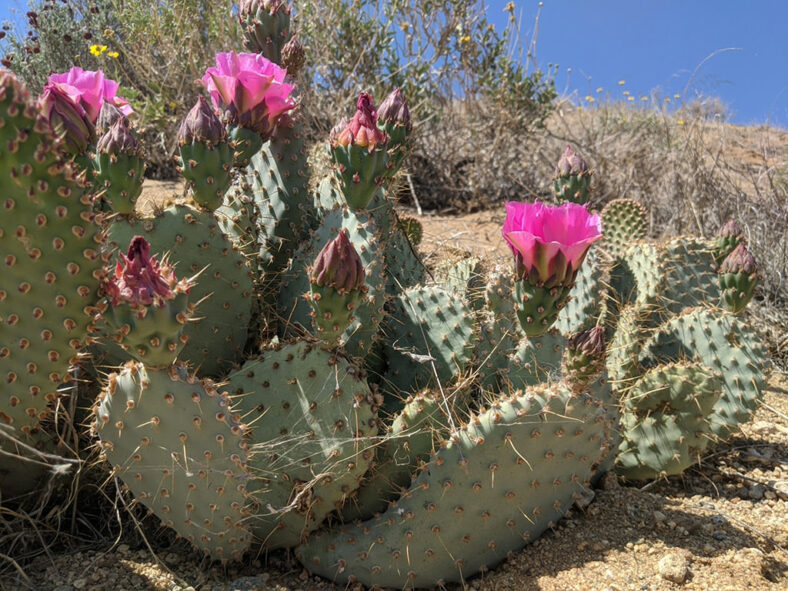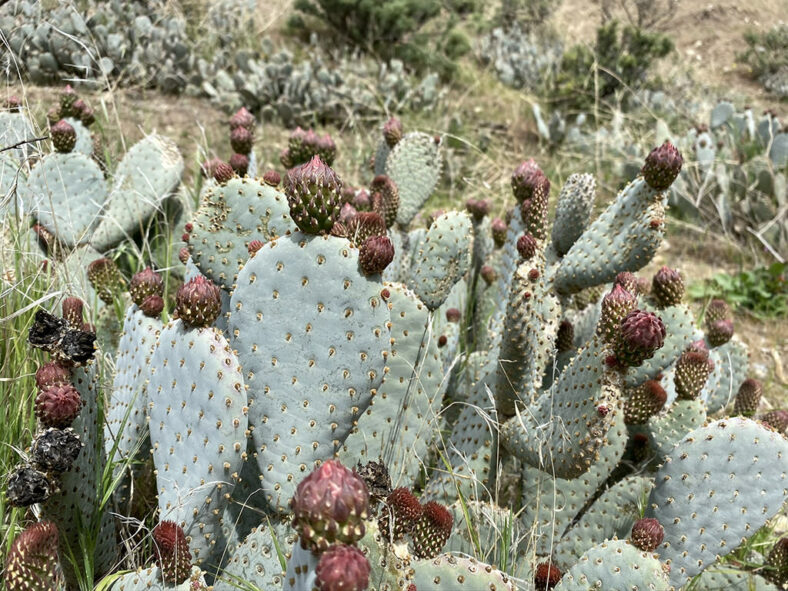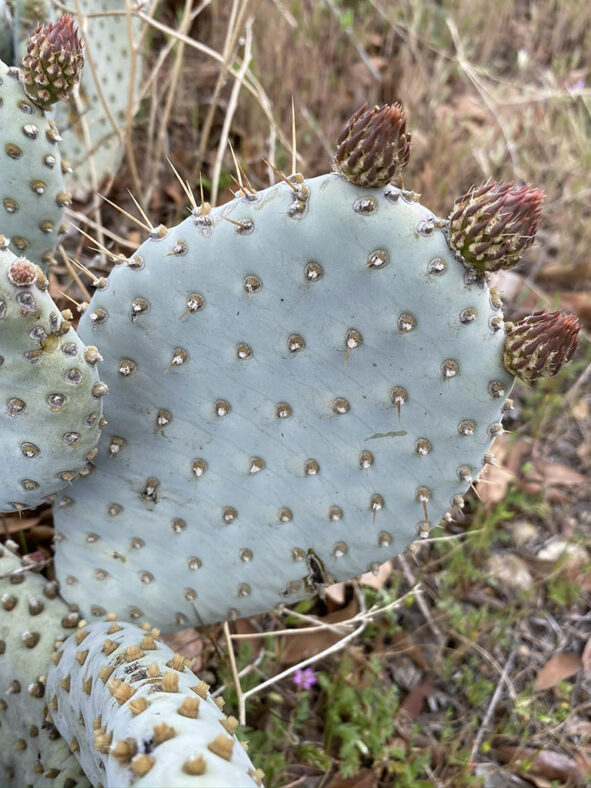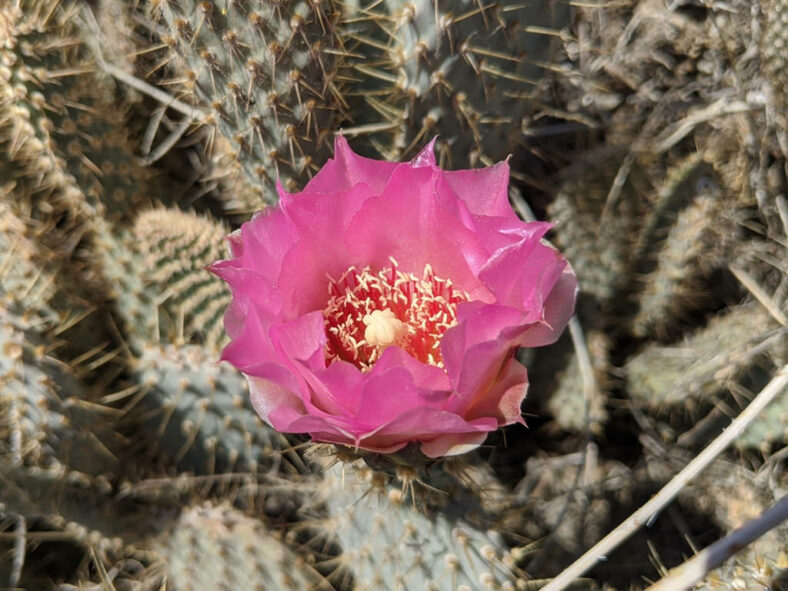Opuntia basilaris var. treleasei is distinguished from Opuntia basilaris var. basilaris by its areoles that contain spines in addition to the numerous glochids.
Scientific Name
Opuntia basilaris var. treleasei (J.M.Coult.) J.M.Coult. ex Toumey
Common Name(s)
Bakersfield Cactus, Kern Beavertail Pricklypear, Trelease's Beavertail Cactus, Trelease's Beavertail Pricklypear
Synonym(s)
Opuntia basilaris subsp. treleasei, Opuntia treleasei
Scientific Classification
Family: Cactaceae
Subfamily: Opuntioideae
Tribe: Opuntieae
Genus: Opuntia
Etymology
The varietal epithet "treleasei" (pronounced tre-LEE-see-eye) honors the original collector William Trelease (1857 -1945), an American botanist, entomologist, explorer, writer, and educator.
Origin
Opuntia basilaris var. treleasei is native to the United States. It is listed as endangered and is currently restricted to a limited area of central Kern County near Bakersfield in the southern San Joaquin Valley in California.
Description
Opuntia basilaris var. treleasei is a shrubby cactus with erect, gray-green stems divided into flattened segments (pads) with areoles that bear numerous glochids and often a few spines. It can grow up to 16 inches (40 cm) tall, branching from the base and forming clumps over time. The fleshy pads vary from rounded, heart-shaped, or diamond-shaped to nearly cylindrical. They can reach a length of 8 inches (20 cm) and a width of 3 inches (7.5 cm). The glochids are yellow to red-brown or dark brown, while the spines are yellow, straight, and can measure up to 1 inch (2.5 cm) long. The spines are usually present in distal areoles, 2 to 8 per areole. Tiny leaves can be found on the youngest pads, but they are shed quickly.
During the spring, Opuntia basilaris var. treleasei produces showy pink to magenta flowers at the upper terminal margins of the pads. The flowers can reach a length of 2.4 inches (6 cm) and a diameter of 2 inches (5 cm). The fruits are edible, spherical to obovate, and contain grayish-white seeds. They can grow about 1.6 inches (4 cm) in diameter.

How to Grow and Care for Opuntia basilaris var. treleasei
Light: Opuntia basilaris var. treleasei thrives in full sun, but some shade during midday and afternoon can prevent sunburn in hot climates. A window that receives sunlight 6 hours a day works best when grown indoors.
Soil: This cactus requires a well-draining soil mix. You can use a commercial cactus potting mix or create your own.
Temperature: Extremely tolerant of high temperatures, Opuntia basilaris var. treleasei prefers cooler temperatures in winter. It grows best in USDA Plant Hardiness Zones 8a to 10b, with average minimum winter temperatures ranging from 10 to 40 °F (-12.2 to 4.4 °C).
Watering: From spring to fall, water moderately and let the soil dry out completely before watering again. In most areas, rainfall will be enough for established plants. If potted, never let the container sit in water. During the winter, suspend the watering.
Fertilizing: Opuntia basilaris var. treleasei does not need fertilizer when planted in the ground. However, it will benefit from fertilizing during the growing season when grown in a container. Apply a water-soluble fertilizer. Suspend feeding during the winter when the plant goes dormant.
Repotting: Repot only when the cactus becomes potbound or is too large and unstable in its container. Choose a slightly larger container with drainage holes at the bottom. The best time for repotting is late winter or early spring.
Propagation: You can propagate Opuntia basilaris var. treleasei by stem segments or seeds. Using stem segments is the easiest method and yields faster results. For best results, take stem segments in early summer. Sow the seeds in late spring.
Learn more at How to Grow and Care for Opuntia.
Toxicity of Opuntia basilaris var. treleasei
Opuntia basilaris var. treleasei is not toxic to humans or pets. However, keep the plant away from pets and children as it has harmful spines and glochids that may cause skin irritation.
Links
- Back to genus Opuntia
- Succupedia: Browse succulents by Scientific Name, Common Name, Genus, Family, USDA Hardiness Zone, Origin, or cacti by Genus
Photo Gallery
Click on a photo to see a larger version.


